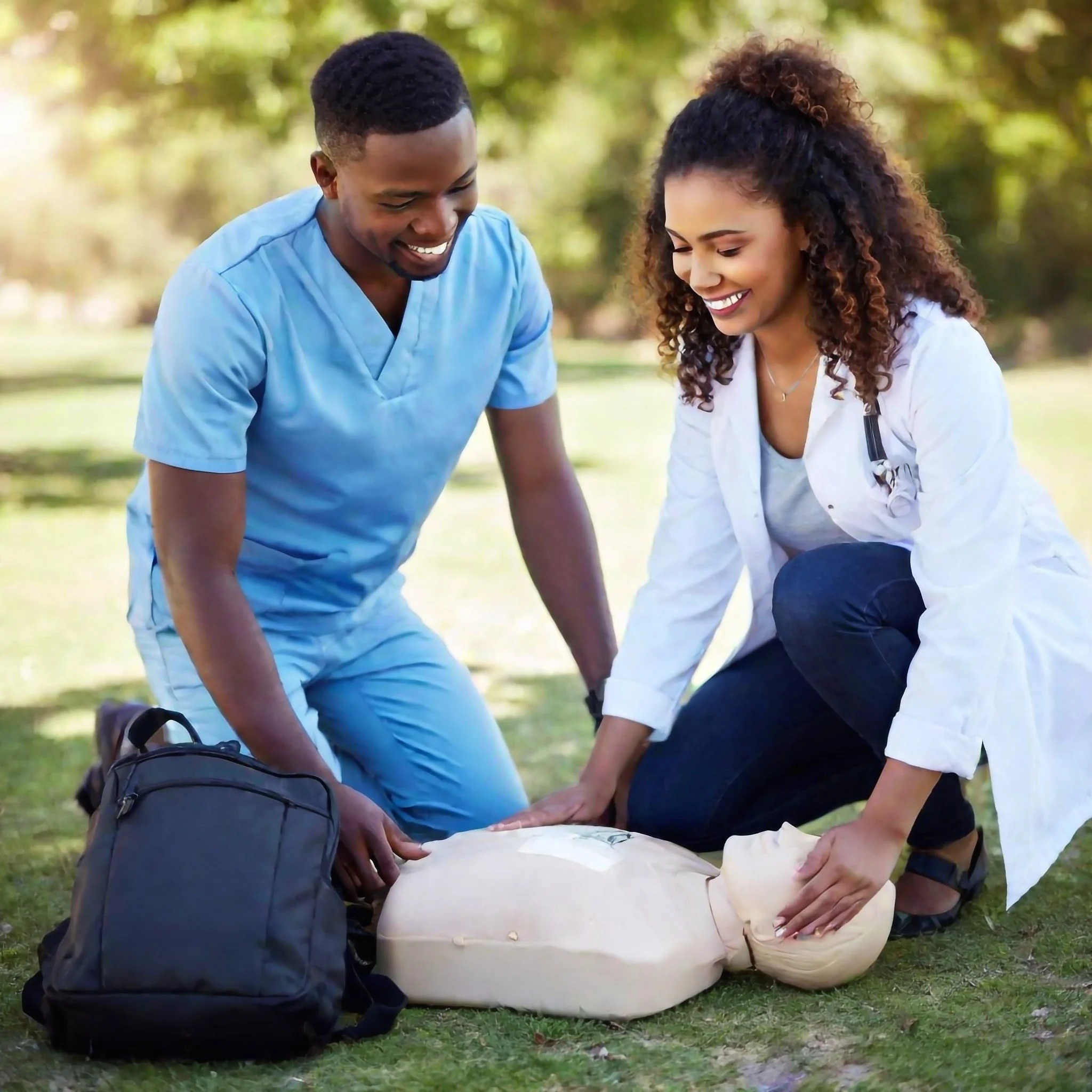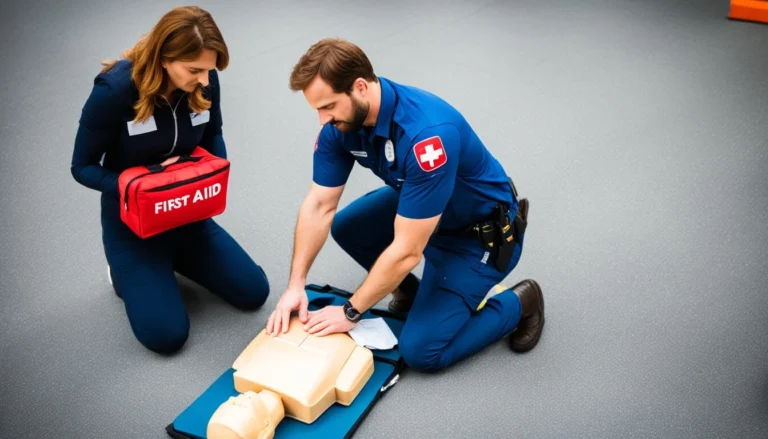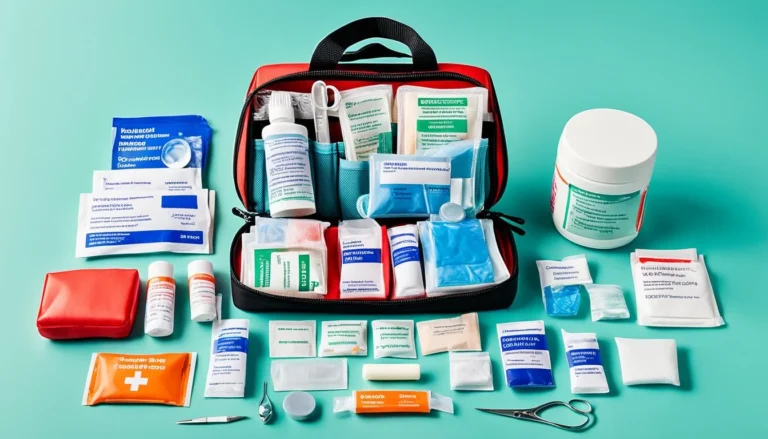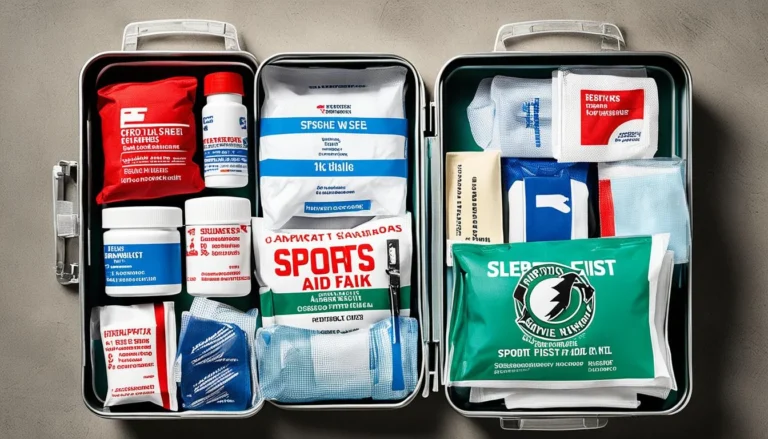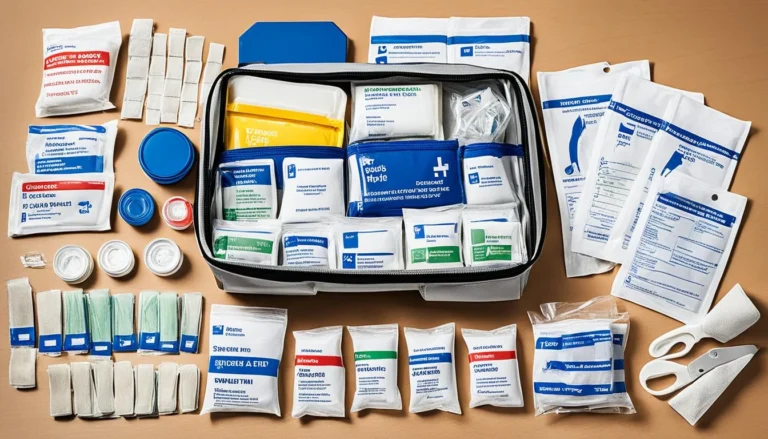What Do You Do On A First Aid Course?
In the UK, there are 150,000 deaths each year where first aid might have helped. This startling number shows the huge importance of lifesaving skills and the need for better emergency response. First aid training UK is crucial. It teaches people how to help in emergencies until professional medical help arrives.
Medical emergencies can happen anywhere – from the tranquillity of nature to busy workplace settings. Anyone can learn first aid, even those with no prior knowledge. Courses are made for beginners. They cover essential skills like the Heimlich maneuver and CPR. This helps build confidence for real-life emergencies.
Key Takeaways
- First aid courses are pivotal in increasing survivability in emergency situations.
- Emergency assistance skills are vital in all walks of life, not just the workplace. For workplace-specific first aid kits, check workplace first aid kits.
- No previous knowledge of first aid or emergency protocols is required to participate.
- Practical aspects of training include engagement in life-saving methods.
- The right mindset and willingness to learn are key to gaining confidence in providing emergency response.
Introduction to First Aid Training
Taking part in first aid training is key for understanding why learn first aid and how to give life-saving assistance well. This learning is crucial for acting quickly and well in emergencies. It’s for anyone, from those with no medical knowledge to those wanting to boost their skills.
Learning first aid gives you confidence. You know you can help in serious situations. This not only benefits you but also your community and work. Now, let’s dive into why first aid training is so beneficial:
- Broadens your ability to offer immediate and effective medical assistance.
- Increases safety awareness, thereby potentially preventing accidents before they occur.For example, having a home first aid kit can help manage minor injuries promptly.
- Empowers you with skills that are applicable in everyday life, not just during isolated incidents.
First aid teaches you to handle everything from minor cuts to big emergencies. It’s essential for dealing with many health issues confidently and correctly.
This table shows what a first aid course includes and the skills it builds:
| Course Component | Skills Developed |
|---|---|
| Basic Life Support (BLS) | Cardiopulmonary Resuscitation (CPR) and use of Automated External Defibrillators (AEDs) |
| Wound Management | Treating cuts, burns, and abrasions |
| Handling Medical Emergencies | Dealing with strokes, heart attacks, and other critical conditions |
| Fractures and Mobility Support | Immobilisation techniques and makeshift splinting |
First aid isn’t just for adults. It often includes how to help kids too. This shows how varied and important the skills in first aid training are. It gives every participant the power to offer life-saving assistance.
Preparing for Your First Aid Course
Getting ready for your first aid course is key to learning the skills you’ll need. It’s a mix of getting your mind and body prepared. This means being ready to think and act in case of an emergency.
Researching First Aid Procedures
It’s not a must to know first aid before you start. But, knowing a bit beforehand can make things less scary and more fun. Look into things like CPR, how to deal with cuts, and broken bones. Just be careful not to try things you learn on your own without an expert.
Appropriate Attire for Practical Scenarios
Choosing what to wear is important. You’ll be doing hands-on work like practicing CPR and bandaging. So, wear things that let you move easily. Loose clothes and flat shoes are good choices. If you can’t do some activities because of health reasons, let your trainers know.
Comprehensive Overview of First Aid Course Content
First aid courses teach you key skills for emergencies. They show you how to handle health crises before pros take over.
Emergency Procedures and Basic Life Support
In these courses, you learn to check a casualty and do defibrillator use. It’s all about quickly and rightly helping in emergencies.
Treatment Techniques for Common Injuries
Knowing how to treat injuries well is what first aid is about. You’ll learn bleeding control and how to deal with burns. These skills are useful at home and at work.For outdoor adventures, consider carrying a hiking first aid kit.
The Practical and Theoretical Elements of First Aid Training
First aid training mixes both theory and practice. It ensures people are ready for real emergencies. You learn in class and also get to try out first aid skills hands-on. The focus is on managing injuries at work and staying safe.
Hands-On Demonstrations
Getting people to practice first aid is key. They do so in settings that look like real work injuries. This helps them act fast and well if someone gets hurt. Through these practices, they get not only skill but also the confidence to use it.
Theoretical Knowledge
The classroom part covers lots of key topics, like what the law says about first aid. People look at different situations to learn, from being safe to managing injuries. They blend this knowledge with practice. This way, they fully get what it means to help with first aid.
| Component | Description | Benefits |
|---|---|---|
| Theoretical Learning | Covers compliance, regulations, and situational analysis | Enhances understanding of first aid frameworks and injury assessment |
| Practical Skills | Simulated scenarios for burns, cuts, and CPR | Helps build confidence and emergency response skills |
| Workplace Management | Specific focus on work-related injuries | Gets people ready to face work emergencies with confidence |
Understanding the Importance of Assessment and Certification
First aid training is more than just learning skills. It’s also being checked to make sure we know these skills well. The first aid assessment is crucial. It gives feedback to both trainers and trainees. It shows how well they understand and can use first aid.
Quality first aid training includes regular checks, not just one final test. This method keeps the training’s quality high. It makes sure everyone learns the skills well before they get certified.
When a course is successfully finished, a certification is given. This shows the person can apply first aid correctly. Many jobs, especially in care or health, need this certification. It’s valid for three years. To stay certified, a refresher course is needed after three years.
| Component | Description | Impact |
|---|---|---|
| Continuous Assessment | Evaluation of skills after each module rather than at the course’s end. | Ensures consistent understanding and skill level across all areas of first aid. |
| Certification | Official documentation affirming first aid competency. | Provides accredited recognition necessary for certain professional duties. |
| Validity | Period the certification is considered valid before renewal. | Keeps the certified individual up-to-date with the newest first aid practices and guidelines. |
Accreditation is key to good first aid training. It makes sure those certified can handle emergencies safely. The assessment and certification process makes training better. It also makes the trainees more confident. They learn to help effectively in emergencies.
Dealing with Sensitive Materials During Training
In first aid courses, the training often includes very real-looking simulations. These are set up to get people ready for real emergencies. But, this training can sometimes be distressing for the students. So, the courses are set up to offer support.
The trainers do more than just teach. They also offer emotional help. This is very important. It helps the students cope with how the training might affect them. If the scenes are too much, students can take a break. They don’t have to keep watching if it upsets them.
| Scenario Depiction | Support Mechanism | Trainee Options |
|---|---|---|
| Simulated road traffic accident | Guidance from a psychologist | Option to observe rather than participate |
| Acting out sudden cardiac arrest | Debrief sessions after the scenario | Engage in a less intense role |
| Severe allergic reaction management | Immediate counselling availability | Excuse themselves from the scenario |
First aid courses do their best to balance real learning with care for the students’ feelings. This way, they prepare everyone well for real-life emergencies, without causing too much distress.
Who Will Be Teaching You First Aid Skills?
You’re about to kick off a first aid course. You’ll learn from a mix of experts who bring a world of knowledge. These experts include healthcare pros, armed forces medics, and certified teachers. Each is deeply skilled in their area and ready to share their insights in the classroom with you.
Qualifications and Experience of Trainers
Your training team is top-notch. They are either in the health sector, the military, or are teachers with special first aid training. The healthcare pros are experienced and keep public health in mind when risking their own safety. Armed forces medics have seen it all, offering care in tough spots. Certified teachers? They meet strict standards ensuring your learning is the best it can be.
Real-World Expertise
The trainers have real-life tales and tips that make the training work for you. They don’t just talk the talk; they share what really works in emergency situations. Their vast experiences and commitment promise you’re getting the best to deal with crises, whether in class or out there.
| Instructor Type | Field Experience | Training Focus |
|---|---|---|
| Healthcare Professional | Emergency Rooms, Clinics | Medical Management, Patient Care |
| Armed Forces Medic | Conflict Zones, Field Operations | Trauma Handling, Emergency Response |
| Certified Instructor | Academic & Field-based Training | Educational Methodology, Certification Standards |
The Downside of Only Attending Free First Aid Courses
Free first aid courses look great for someone eager to learn life-saving tips for free. But they come with big downsides like limited tests and no official recognition. We explore why non-accredited courses often miss the mark for serious professionals or employers looking for well-rounded emergency skills.
The biggest issue with these free first aid courses is their lack of a solid educational plan. They only cover the basics and offer a few hands-on tips. This means your skills are not fully checked, leaving you possibly unprepared for real medical emergencies.
| Aspect | Free First Aid Training | Accredited First Aid Courses |
|---|---|---|
| Cost | None | Varies, with potential funding options |
| Assessment | Minimal or None | Continuous, Rigorous |
| Certification | None or Not Recognised | Recognised and Valid for 3 Years |
| Course Depth | Basic Techniques | Comprehensive, includes latest protocols |
The big problem with non-accredited courses is they don’t offer any official certification. Without a recognised certificate, people won’t know if you’re really able to handle first aid. This can be a real issue in job or professional settings who are seeking qualified first aid responders.
If you’re really serious about learning first aid that you can rely on, we recommend going for an accredited course. These courses give you the full package – in-depth lessons and a true test of your knowledge. Plus, they offer a certification that’s trusted in many areas.
Choosing the Right First Aid Course for You
Choosing a first aid course can seem tough with so many options out there. It’s key to pick a course that not only is high quality but also suits what you need. This is true whether you’re a parent learning paediatric first aid or a professional interested in an accredited first aid course. Knowing what to look for in a course is your first step.
Recognising Certified Courses
Looking for an accredited course is important. Accreditation means the course meets top standards from health and safety experts. To check if a course is good, see if it’s recognized by well-known groups. This recognition shows the training is up-to-date and covers everything it should.
Different Types of First Aid Training Available
There are many types of first aid training to meet different needs. Basics are great for newcomers, while specialised courses like paediatric first aid are for those who care for kids. We have a helpful table that shows the main differences. This table can guide you to the right choice for your situation.
| Type of Course | Target Audience | Key Features | Duration |
|---|---|---|---|
| Basic First Aid | General Public | Covers common emergency scenarios, CPR, and injury management. | 1 Day |
| Paediatric First Aid | Parents, Teachers, Childcare Providers | Focuses on infants and children, emphasises choking, fevers, and allergy reactions. | 2 Days |
| Advanced First Aid | Healthcare Professionals, Lifeguards | Includes advanced techniques, use of medical equipment, and scenarios like multiple casualties. | 3 Days |
It’s crucial to find the right course, one that fits your specific needs. By choosing an accredited course that meets your requirements, you can learn how to deal with emergencies effectively. This could mean being able to save lives with your actions.
Conclusion
Starting a first aid course shows how serious you are about being ready for emergencies. These classes are well-designed for everyone. They make sure you can handle unexpected medical situations. Choosing to learn first aid is a smart move. It means you care about growing and helping others.
Learning first aid goes a long way. It helps in many daily situations. You can act in a home accident or a big workplace problem. With first aid skills, you’re not just watching. You’re a person who can truly help when it’s critical.
It’s key to pick a course that’s accredited. This way, your qualifications will be known and respected in the UK. While the certificate is good, the real win is being able to save lives. This shows that putting effort into learning first aid is worth it. It’s investing in something truly priceless—saving people.

